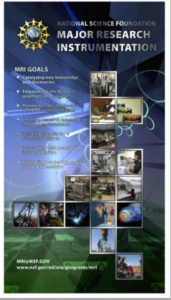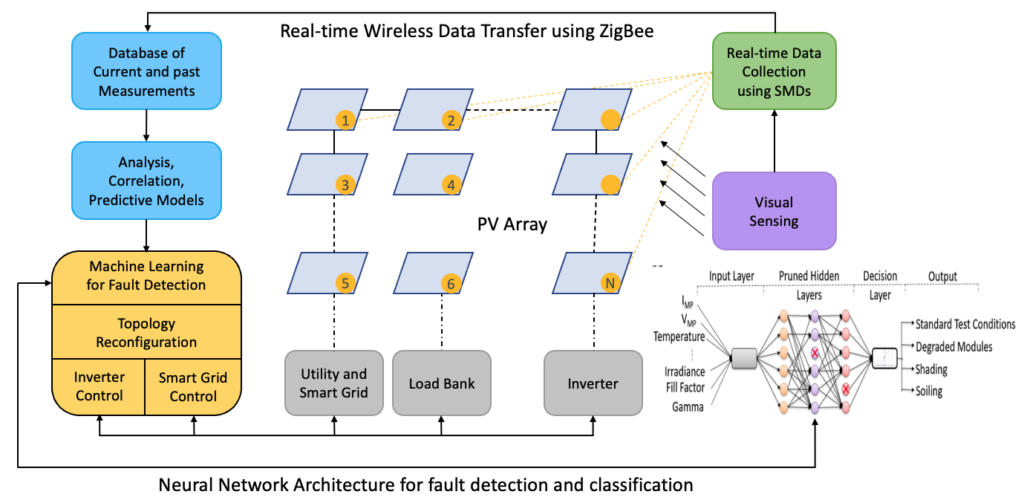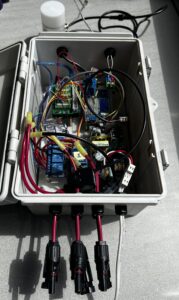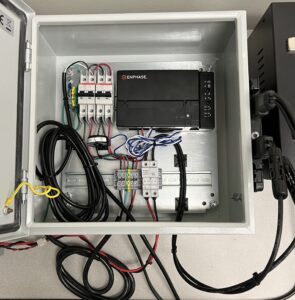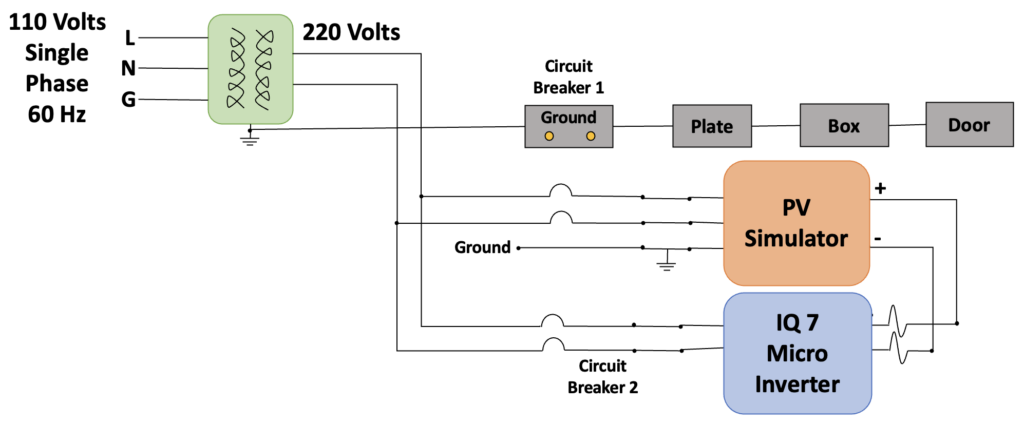NSF Major Research Instrumentation Project
MRI Development of a Sensors and Machine Learning Instrument Suite for Solar Array Monitoring
PI TEAM: A. Spanias (PI), C. Tepedelenlioglu, Q. Lei, S. Goodnick, R. Ayyanar, J. Kitchen.
Consultant. D. Srinivasan
Host Center: SenSIP
2020-2023. Funded by NSF Award: 2019068
Summary: The MRI instrument suite development enables transformative research in sensors and machine learning for energy applications. The project will unleash creativity in integrating embedded electronics and machine learning to monitor and control solar arrays. Societal outcomes of research enabled by this MRI will have an impact on environmental initiatives by increasing efficiency in solar power generation. Results and patented technology will influence emerging international standards of utility-scale PV arrays. The shared research instrument will have a broader impact as it is an enabler for developing new integrated sensors and machine learning technology that can be ported in several other sustainability applications. The development of this instrument suite will greatly benefit a large number of graduate and undergraduate students taking courses in machine learning, solar systems, signal processing, and artificial intelligence.
MRI Equipment Acquisitions
The project involves several equipment acquisitions including:
a) Prototype Components; Texas Instruments Data Conversion 20MHz, Power management Kits to enable measurements of solar array voltages and other parameters.
b) Skyline Cameras with computer interface; These will provide images and video sequences for cloud monitoring and shading prediction.
c) Programmable Solar Load. These will enable us to build a configurable resistive load to run long term experiments with various load conditions.
d) Solar Load Simulator. This is an instrument that will assist in making precise measurements for a programmable solar load.
e) Grid Simulator. This simulator will enable simulating various grid conditions. All experiments for fault detection and shading will be examined with regard to their effect on the grid.
f) Solar Array Simulator; This programmable simulator will enable various real-time experiments including those planned for inverter transient control.
g) Solar I-V Curve Tracer; This will enable measuring I-V curves for solar panels for various solar array experiments including fault detection, shading, soling experiments.
h) Irradiance Sensors; Three sensors that will enable obtaining irradiance measurements to fuse together with skyline camera info and predict cloud and shading conditions.
i) Programmable Inverters; Inverters will enable the team to assess and control transient effects. The inverters will have an interface for configuration, measurement, and control.
j) Deep Learning Computer and Server with 32GB NVIDIA cards; To conduct training of ML algorithms and Deep Neural networks we requite computers equipped with GPUs.
Publications:
- S. Rao, D. Pujara, A. Spanias, C. Tepedelenlioglu and D. Srinivasan, “Real-time Solar Array Data Acquisition and Fault Detection using Neural Networks,” 2023 IEEE 6th International Conference on Industrial Cyber-Physical Systems (ICPS), Wuhan, China, 2023, pp. 1-5.
- D. Pujara, D. Ramirez, C. Tepedelenlioglu, D. Srinivasan, and A. Spanias, “Design of a New Photovoltaic Intelligent Monitoring and Control Device,” IEEE IISA 2023 conference, 10-12 July 2023. (Presented)
- V. Narayanaswamy, R. Ayyanar, C. Tepedelenlioglu, D. Srinivasan and A. Spanias, “Optimizing Solar Power Using Array Topology Reconfiguration With Regularized Deep Neural Networks,” in IEEE Access, vol. 11, pp. 7461-7470, 2023.
- S. Rao, G. Muniraju, C. Tepedelenlioglu, D. Srinivasan, G. Tamizhmani and A. Spanias, “Dropout and Pruned Neural Networks for Fault Classification in Photovoltaic Arrays,” in IEEE Access, vol. 9, pp. 120034-120042, 2021.
- V. S. Narayanaswamy, R. Ayyanar, A. Spanias, C. Tepedelenlioglu and D. Srinivasan, “Connection Topology Optimization in Photovoltaic Arrays using Neural Networks,” 2019 IEEE International Conference on Industrial Cyber Physical Systems (ICPS), Taipei, Taiwan, 2019, pp. 167-172.
- S. Rao, A. Spanias and C. Tepedelenlioglu, “Solar Array Fault Detection using Neural Networks,” 2019 IEEE International Conference on Industrial Cyber Physical Systems (ICPS), Taipei, Taiwan, 2019, pp. 196-200.
- Emma Pedersen, Sunil Rao, Sameeksha Katoch, Kristen Jaskie, Andreas Spanias, Cihan Tepedelenlioglu, and Elias Kyriakides, “PV Array Fault Detection using Radial Basis Networks”, IEEE IISA-2019, Greece, July 2019.
- Rao, A. Spanias, C. Tepedelenlioglu, “Solar Array Fault Detection using Neural Networks,” IEEE ICPS, Taipei, May 2019.
- Katoch, G. Muniraju, S. Rao, A. Spanias, P. Turaga, C. Tepedelenlioglu, M. Banavar, D. Srinivasan, “Shading Prediction, Fault Detection, and Consensus Estimation for Solar Array Control”, 1st IEEE International Conference on Industrial Cyber-Physical Systems (ICPS-2018), Saint. Petersburg, Russia, May 2018.
- Muniraju, S. Rao, S. Katoch, A. Spanias, P. Turaga, C. Tepedelenlioglu, M. Banavar, D. Srinivasan, “A Cyber-Physical Photovoltaic Array Monitoring and Control System”, International Journal of Monitoring and Surveillance Technologies Research, vol., issue 3, May 2018.
- Spanias, “Solar Energy Management as an Internet of Things (IoT) Application,” Keynote Speech, Proceedings 8th International Conference on Information, Intelligence, Systems and Applications (IEEE IISA 2017), Larnaca, August 2017.
- Sunil Rao, David Ramirez, Henry Braun, Jongmin Lee, Cihan Tepedelenlioglu, Elias Kyriakides,, Devarajan Srinivasan, Jeff Frye, Shinji Koizumi †, Yoshitaka Morimoto † and Andreas Spanias,” An 18 kW Solar Array Research Facility for Fault Detection Experiments,” 18th MELECON (IEEE), April 2016.”
Patents:
- V. Narayanaswamy, A. Spanias, R. Ayyanar, C. Tepedelenlioglu, Systems and Methods For Connection Topology Optimization In Photovoltaic Arrays Using Neural Networks,US Patent 11,616,471, March 2023. (PI A. Spanias)
- S. Rao, A. Spanias, C .Tepedelenlioglu, (M19-102P) , Solar Array Fault Detection, Classification and Localization Using Deep Neural Nets, US 11,621,668, April 2023. (PI: A. Spanias)
Student Posters:
|
Design and Implementation of a New PV Monitoring Device Deep Pujara, Andreas Spanias, Cihan Tepedelenliolu, Devarajan Srinivasan Design and Implementation of Smart Monitoring Device Deep Pujara, Skyler Verch, Sunil Rao, Vivek Narayanaswamy, Andreas Spanias, Cihan Tepedelenlioglu, Devarajan Srinivasan Fault Classification in PV Arrays using Machine Learning Sunil Rao, Cihan Tepedelenlioglu, Devarajan Srinivasan, Andreas Spanias CPS: Synergy: Image Modeling and Machine Learning Algorithms for Utility-Scale Solar Panel Monitoring Sunil Rao, Vivek Narayanaswamy, Andreas Spanias, Cihan Tepedelenlioglu, Pavan Turaga and Raja Ayyanar A Cyber-Physical System Approach for Photovoltaic Array Monitoring and Control S. Rao, S. Katoch,A. Spanias, P. Turaga, C. Tepedelenlioglu,R. Ayyanar, H. Braun, J. Lee, U. Shanthamallu, M. Banavar, D. Srinivasan Irradiance Estimation for a Smart PV Array Henry Braun, Shwetang Peshin, Andreas Spanias, Cihan Tepedelenlioglu, Mahesh Banavar, Girish Kalyanasundaram and Devarajan Srinivasan |
Fig. Hardware Implementation of the discussed circuit

